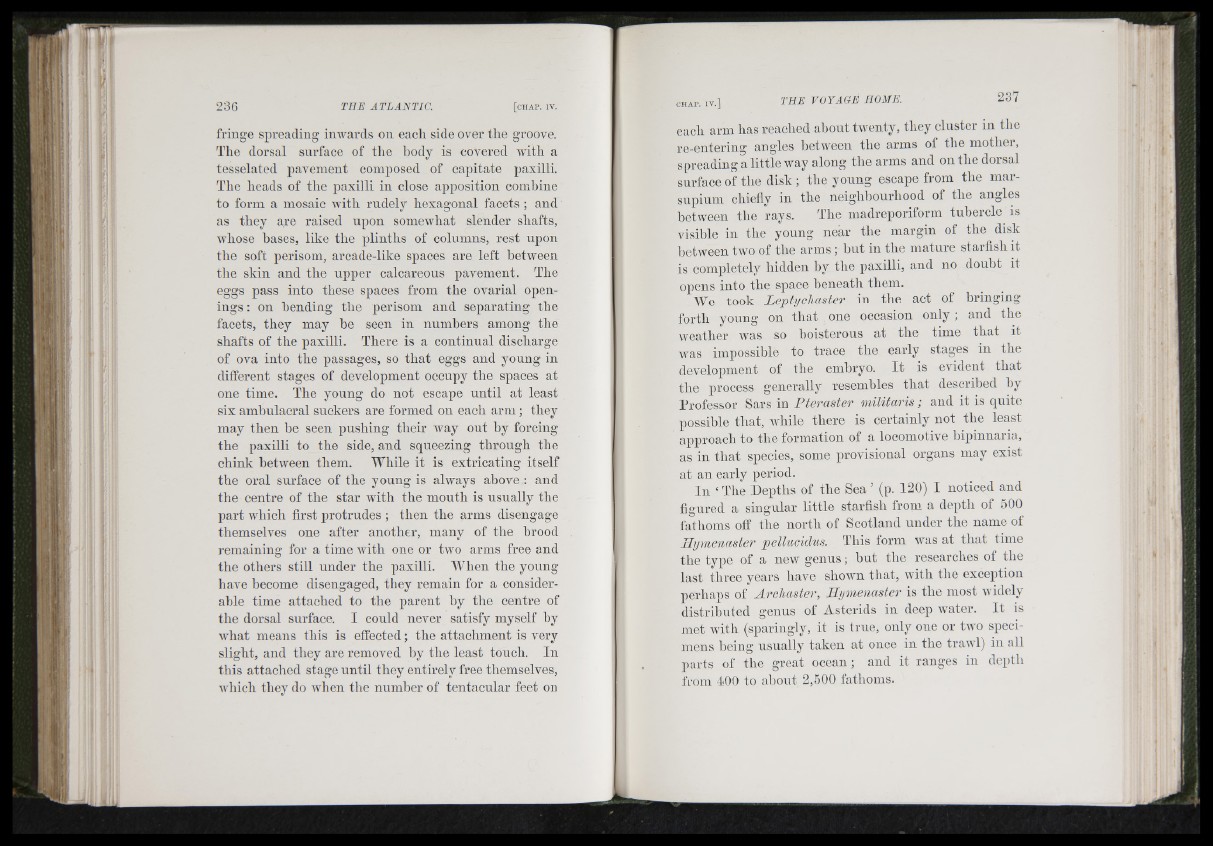
,f|
.iï:.
to"
:k <
li
I
i
U
fringe spreading inwards on eacli side over tlie groove.
The dorsal surface of the hody is covered with a
tesselated pavement composed of capitate paxilli.
The heads of the paxilli in close apposition combine
to form a mosaic with rudely hexagonal facets ; and
as they are raised upon somewhat slender shafts,
whose hases, like the plinths of columns, rest upon
the soft perisom, arcade-like spaces are left between
the skin and the upper calcareous pavement. The
eggs pass into these spaces from tbe ovarial openings
: on bending the perisom and separating the
facets, they may be seen in numbers among the
shafts of the paxilli. There is a continual discharge
of ova into the passages, so th a t eggs and young in
different stages of development occupy the spaces at
one time. The young do not escape until at least
six amhulacral suckers are formed on each arm ; they
may then be seen pushing tbeir Avay out by forcing
the paxilli to the side, and squeezing through tbe
chink between them. While it is extricating itself
tbe oral surface of the young is always above : and
the centre of the star Avith the mouth is usually the
part which first protrudes ; then the arms disengage
themselves one after another, many of the brood
remaining for a time AA'ith one or tAvo arms free and
the others still under the paxilli. When the young
have become disengaged, they remain for a considerable
time attached to tbe parent by tbe centre of
the dorsal surface. I could never satisfy myself by
Avhat means this is effected ; the attachment is very
slight, and they are removed by tbe least touch. In
this attached stage until they entirely free themselves,
Avhich thev do Avhen tlie number of tentacular feet on
each arm has reached about tAventy, they cluster in tbe
re-entering angles betAA'een the arms oi tbe motbei,
spreading a little way along tbe arms and on the dorsal
surface of tbe disk ; the young escape from the mar-
supinm chiefly in tlie neigbbourbood of the angles
between tbe rays. The madreporiform tubercle is
visible in tbe young near tbe margin of the disk
between tAVO of the arms ; but in tbe mature starfish it
is completely bidden by tbe paxilli, and no doubt it
opens into the space beneath them.
We took Leptychaster in the act of bringing
forth young on that one occasion only ; and the
Aveather was so boisterous at the time that it
Avas impossible to trace the early stages in the
deA'elopment of tbe embryo. I t is evident that
tbe process generally resembles that described by
Professor Sars in Pteraster militaris ; and it is quite
possible that, Avhile there is certainly not the least
approach to the formation of a locomotive hipinnaria,
as in that species, some provisional organs may exist
at an early period.
In ‘ The Depths of the Sea ’ (p. 120) I noticed and
figured a singular little starfish from a depth of 500
fathoms off the north of Scotland under the name of
Hymenaster pellucidus. This form Avas at th a t time
the type of a new genus ; hut the researches of the
last three years have shoAvn tbat, Avith the exception
perhaps of Archaster, Hymenaster is the most Avidely
distributed genus of Asterids in deep water. I t is
met Avitli (sparingly, it is true, only one or tAvo specimens
being usually taken at once in the traAvl) in all
parts of the great ocean ; and it ranges in depth
IVoni 400 to about 2,500 fathoms.